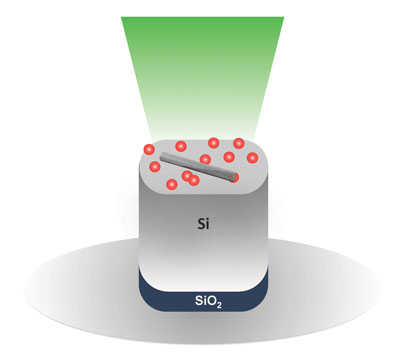| Jan 30, 2012 |
Nanotechnology experiment shows chirality of tube controls speed of growth
|
|
(Nanowerk News) The Air Force Research Laboratory in Dayton, Ohio, has experimentally confirmed a theory by Rice University Professor Boris Yakobson that foretold a pair of interesting properties about nanotube growth: That the chirality of a nanotube controls the speed of its growth, and that armchair nanotubes should grow the fastest.
|
|
The work is a sure step toward defining all the mysteries inherent in what Yakobson calls the "DNA code of nanotubes," the parameters that determine their chirality -- or angle of growth -- and thus their electrical, optical and mechanical properties. Developing the ability to grow batches of nanotubes with specific characteristics is a critical goal of nanoscale research.
|
|
The new paper by Air Force senior researcher Benji Maruyama; former Air Force colleague Rahul Rao, now at the Honda Research Institute in Ohio; Yakobson and their co-authors appeared this week in the online version of the journal Nature Materials ("In situ evidence for chirality-dependent growth rates of individual carbon nanotubes").
|
 |
| CAPTION
|
|
It's an interesting denouement in a saga that began with a 2009 paper by Yakobson and his collaborators. That paper, which presented the theoretical physicist's dislocation theory of chirality-controlled growth, described how nanotubes emerge as if single threads of atoms weave themselves into the now-familiar chicken-wire-like tubes. It also garnered a bit of controversy over what precisely the results meant.
|
|
"Boris caught some heat over it," Maruyama said. "The experimental work out there indicated his theory might be true, but they couldn't confirm it. The good part about our work is that it's fairly unambiguous."
|
|
Yakobson, Rice's Karl F. Hasselmann Professor of Mechanical Engineering and Materials Science and professor of chemistry, took it all in stride. "The criticism didn't affect anything; it was actually the best advertisement and motivation for further work," he said. "In fact, (nanotube pioneer Sumio) Iijima noted early that 'helicity may aid the growth.' We have transformed it into a verifiable equation."
|
|
Experimental confirmation of a theory is never final but always satisfying, he admitted, and the Air Force lab was uniquely equipped to prove the linkage between the speed of a nanotube's growth and its chiral angle.
|
|
The chirality of a single-walled nanotube is determined by the way its carbon atoms are "rolled." Yakobson has described it as similar to rolling up a newspaper; sometimes the type lines up, and sometimes it doesn't. That alignment determines the nanotubes' electrical properties. Metallic armchair nanotubes, so named for the shape of their uncapped edges, are particularly desirable because electrons pass through from tip to tip with no resistance, while semiconducting nanotubes are useful for electronics, among other applications.
|
|
Rao developed a technique in Maruyama's lab to measure the growth rates of individual nanotubes. "It's an impressive setup," Yakobson said. "They can grow individual tubes in very low density and identify their signatures – their chirality – and at the same time measure how rapidly they grow."
|
|
The technique involved mounting catalyst nanoparticles on microscopic silicon pillars and firing tightly controlled lasers at them. Heat from the laser triggered the nanotubes to grow through a standard technique called chemical vapor deposition, and at the same time, the researchers analyzed nanotube growths via Raman spectroscopy.
|
|
From the spectra, they could tell how fast a nanotube grew and at what point growth terminated. Subsequent electron microscope images confirmed the spectra were from individual single-walled nanotubes, while chiral angles were determined by comparing post-growth Raman spectra and nanotube diameters to the Kataura plot, which maps chirality based on band gap and diameter.
|
|
They noted in the paper that the results provide a basis for further research into growing specific types of nanotubes. "Now that we know what the growth rate is for a particular chirality nanotube, one could think about trying to achieve growth of that specific chirality by influencing growth conditions accordingly," Rao said. "So, basically, we now have another 'knob' to turn."
|
|
"This work is at a very early development stage, and it's all about post-nucleation," Yakobson said. "Nucleation sets what I think of as the genetic code – very primitive compared to biology – that determines the chirality and the speed of growth of a nanotube." He said it may be possible someday to dictate the form of a nanotube as it begins to bubble up from a catalyst, "but it will take a lot of ingenuity."
|
|
Yakobson revealed a formula last year that defined the nucleation probability through the edge energies for graphene, which is basically a cut-and-flattened nanotube. But the earlier and related dislocation theory applies to the following growth, and if confirmed further may turn out to be his masterwork.
|
|
"The dislocation theory of growth is elegant and simple," Rao said. "It's still too early to say that it is the only growth mechanism, but Boris should be given plenty of credit for proposing this bold idea in the first place."
|

